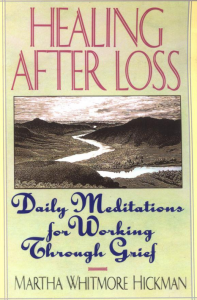Grief itself can be and usually is overwhelming. Dealing with grief — healing — can be equally daunting.
That is why Martha Whitmore Hickman’s beautiful book, Healing After Loss: Daily Meditations for Working Through Grief, is so valuable. In its very structure — daily meditations — the book gently allows the reader to face a range of emotions in kind and manageable doses, subtly communicating that healing, after all, need not be intimidating or overwhelming.
 Each day’s meditation is structured in three parts: a quote, an insight, and a personal hope for the day. It is perfectly measured and balanced to invite a grieving person to begin the process of healing slowly, at a personal pace. If tears come after reading a single quote, simply put the book down. It is progress for a day.
Each day’s meditation is structured in three parts: a quote, an insight, and a personal hope for the day. It is perfectly measured and balanced to invite a grieving person to begin the process of healing slowly, at a personal pace. If tears come after reading a single quote, simply put the book down. It is progress for a day.
The book follows a daily calendar, and so January 1 allows you to acknowledge that you are a part of a large and intimate group of people who, ironically, have never met. The opening quote is from Edward Hirsch: “I put down these memorandums of my affections/ In honor of tenderness,/ In honor of all those who have been/ Conscripted into the brotherhood/ Of loss…” And Hickman follows with the insight that, “When we are drawn into the brotherhood or sisterhood of loss, tenderness seems to be our natural state. We are so vulnerable. Everything brushes against the raw wound of our grief…” She ends the day’s meditation: “May I honor — and trust — the process of grief and healing, knowing that, in time, a new day will come.”
You are not constrained to follow a daily schedule. After many days meditating, you may want to simply browse the pages at random, looking for words that speak to you in the moment. Have you been keeping a diary, preferring to open yourself in solitude instead of facing others? Then you may identify with Hickman herself, who writes, “In the months after my daughter’s death, I filled four notebooks with entries — writing sometimes daily, sometimes several times a day, sometimes only once in several days… It was a means of moving the grief away…” In the insight that follows, she says, “Perhaps talking with friends will have a similar effect. Or painting, or sculpture… The important thing for most of us is not that we have made something of artistic value, but that we have taken a grief that lies like a lump against our hearts, and moved it away from us.” And she ends the meditation simply: “I will be open to new ways of resolving my grief.”
As with any meditation, you may spend as much or as little time as you like exploring a single thought, a single emotion. Or you may let each thought and emotion transport you to yet another unexplored region of your grief. In this way the process of healing continues, with meditations inviting you to walk at your own pace.

